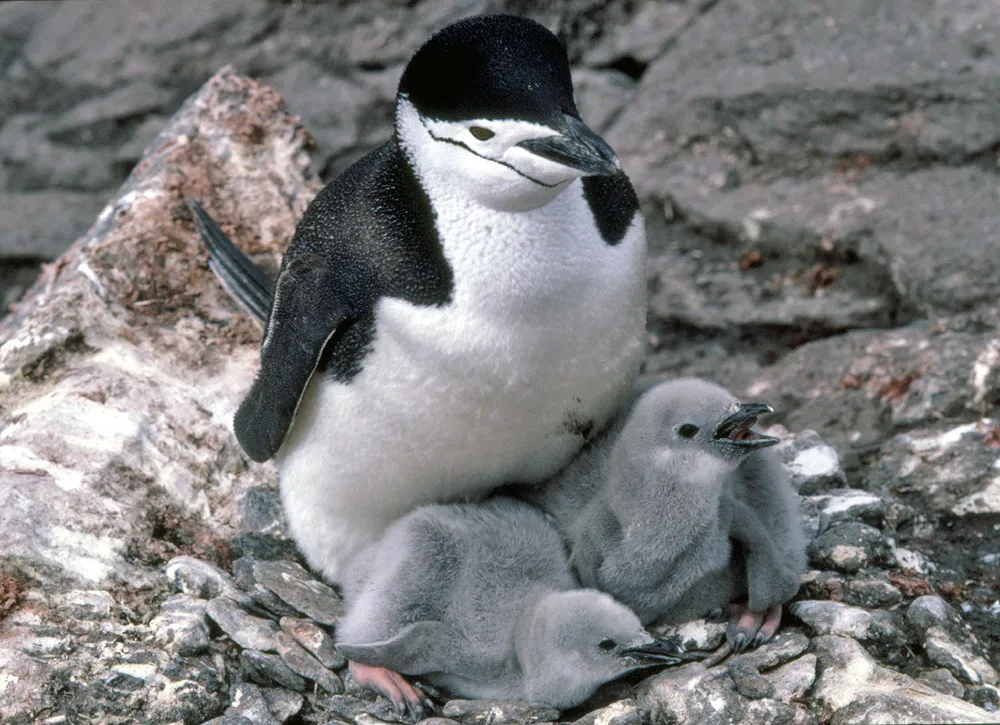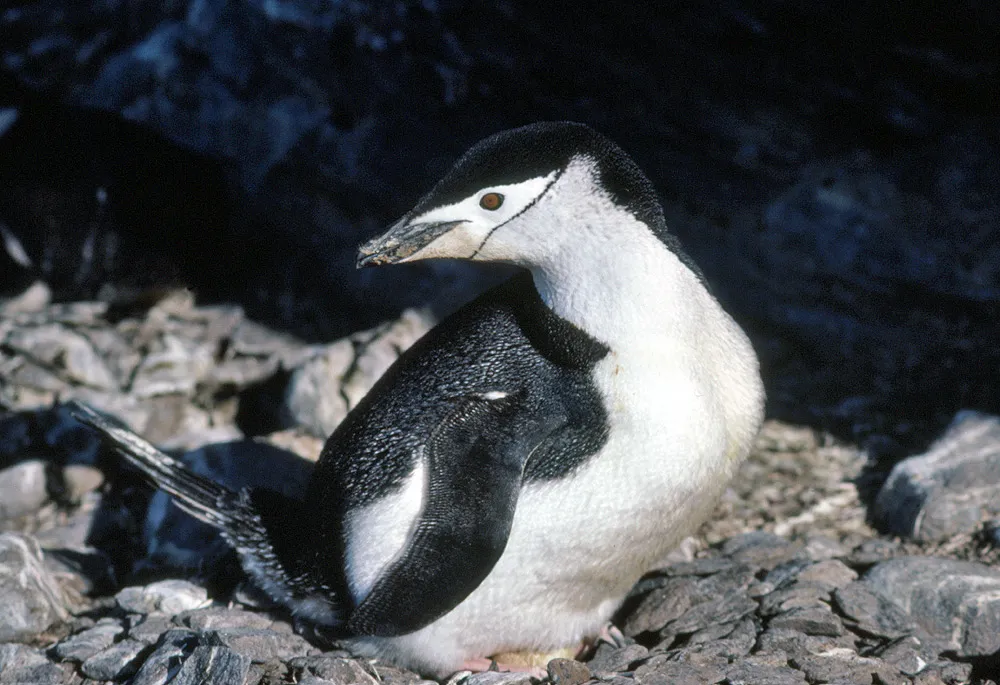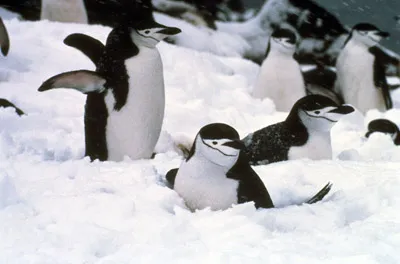Chinstrap penguins - Pygoscelis antarctica
Named for their characteristic band of dark feathers under the chin that appears to be a strap keeping their hat on, these are the smallest of the three species of Pygoscelis penguins.
chinstrap Penguin facts - Basics
Average Weight: 4.5kg - 10lb
Average Height: 68cm - 27 inches
Breeding Season: November/December
- March
Estimated world population:
- at least 8 million, increasing, colonies can number in
the hundreds of thousands.
Feeding &
diet: Almost exclusively krill, will eat fish and
other crustaceans as available, can dive to 70m but usually
less than 45m.
Conservation status:
Least concern
Distribution: Circumpolar,
Sub Antarctic and Antarctic islands, Antarctic Peninsula.
Breeds on rocky coasts away from ice.
Predators:
Leopard seals and killer whales- main predators of adult
birds. Skuas - prey on eggs and chicks.
What are chinstrap penguins like?
According to many books chinstrap penguins are particularly noisy and aggressive, infiltrating and taking over Adelie colonies, though from what I saw of them I would put them behind Adelies in aggression and volume.
Chinstraps along with many other species of penguins return to the same colony each year and often settle within a very short distance of the same nest site. The nest is a very simple affair of a pile of small stones, the main purpose being to separate it from other nests and to raise it above the surrounding ground so that melt-water from snow doesn't wet the eggs or chicks.Small stones are often in short supply in the penguin colonies and so squabbles are commonplace and frequent, particularly as penguins are experienced kleptomaniacs taking nesting material from any other nest that is inadequately guarded. Stones go back and forth and circulate between nearby nests as they are repeatedly stolen, claimed back and stolen again.
Summer snow falls
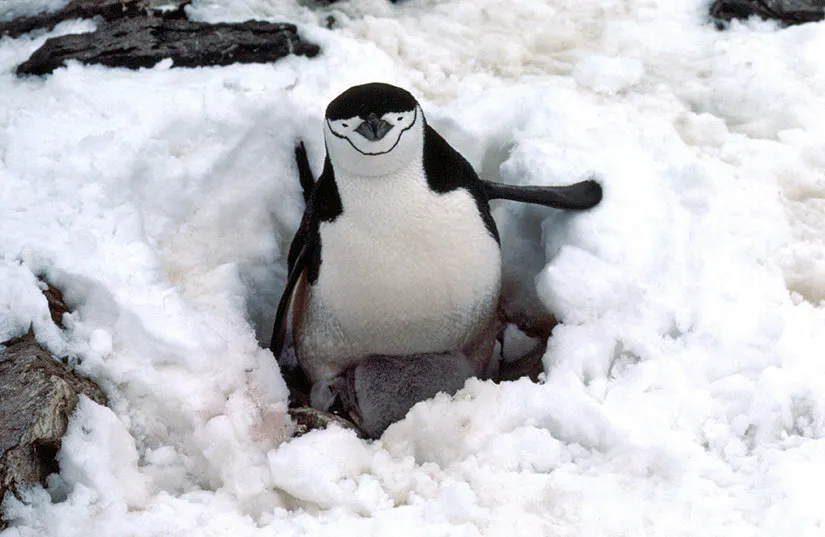
Pictures taken in a chinstrap colony following a short and intense summer snow-fall, most of the penguins had chicks that were almost large enough to regulate their own temperature and leave the nest, though probably very fortunately for them, they were still on the nest being protected by their parents. The adults on the nests had to play the parental role to the full protecting the young from the cold wet snow by laying down, and occasionally getting up to shake off the accumulated snow.
the snowfall was short and with the temperature being just above freezing, the snow melted fairly quickly and so posed little or no danger to the young on this occasion.
After the snow had finished the penguins stood up and shook themselves, the chicks that had been sheltering under the parents were well and seem to be resenting the fact that mum or dad had stood up and weren't keeping them quite so snug any more!
The parent on the nests aer awaiting the return of their partners who will have been out at sea fishing for the krill that these penguins feed almost exclusively on, catching it further inshore than other penguin species. The parent that goes fishing fills themselves up on food and then collects extra in their stomach to bring back and regurgitate for the chicks.
How much do young penguins eat?
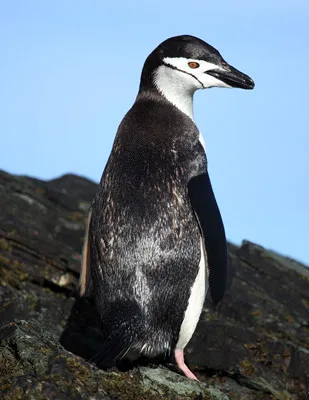 Chinstrap chicks get fed about once a day on average,
with the returning parent bringing back about 300g of krill.
Chinstrap chicks get fed about once a day on average,
with the returning parent bringing back about 300g of krill.
Fishing trips take the adults around 20-30 kilometres from the colony, though distances of well over 200 kilometres have been recorded. The young remain on the nest, looked after in turns by each parent until they are large enough to maintain their own body temperature and can wander around freely.
At this point they form a "creche" with other chinstrap penguin chicks, huddling together for protection against the worst of the weather and predators. It also leaves both parents free to go fishing so increasing the food supply for the rapidly growing chick/s.
Pale penguins
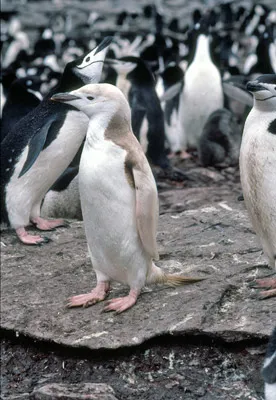 Some species are prone to producing occasional
very pale individuals, known scientifically as "leuchistic"
forms or sometimes as "blonde" penguins.
Some species are prone to producing occasional
very pale individuals, known scientifically as "leuchistic"
forms or sometimes as "blonde" penguins.
They are not albinos as they do have pigment (whereas true albinos lack pigment) but not as much of it as the more normal members of the species. These penguins would always hang around the breeding grounds with others of their species, though I never saw one that had any success in breeding - incubating eggs, building a nest etc. They just seemed to be a little too different for the other penguins.
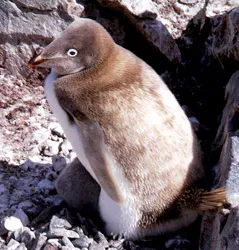
I was looking through your penguin pics
and noticed your comment about leuchistic penguins not breeding.
So I thought you might be interested in the attached pic (left)
of a leuchistic Adelie penguin with a chick. I took the pic
in 1963 on Avian Island (off Adelaide Island).
Mike Fleet
While I saw several leuchistic chinstraps
on Signy I don't recall having seen a leuchistic Adelie,
maybe the result of different gene pools. Interesting that this
one is breeding, maybe adelies are more inclusive than chinstraps!
Paul Ward
Picture credits: Single chinstrap penguin with back to camera - Liam Quinn from Canada, Creative Commons share and share alike 2.0 license. / Leuchistic Adelie penguin - Mike Fleet.

